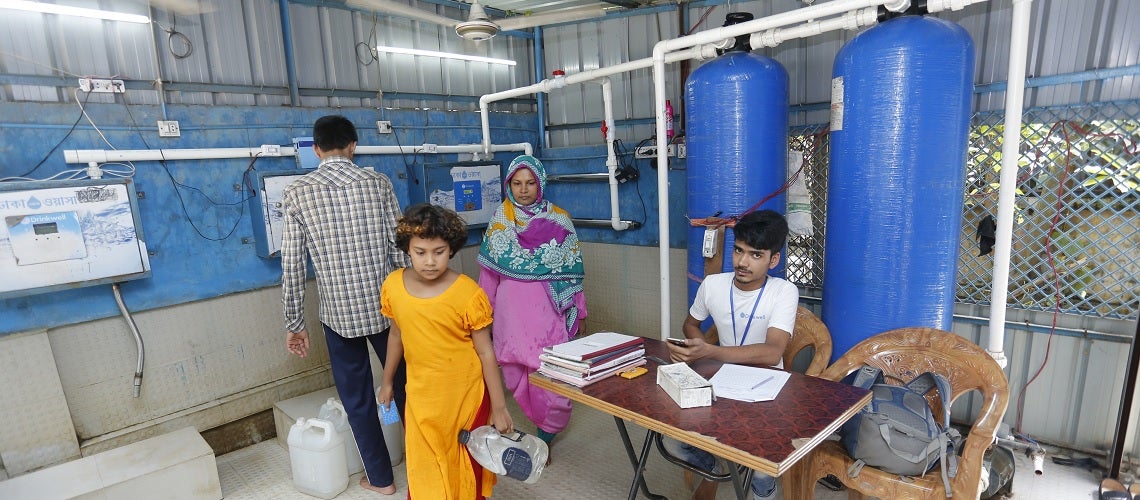 Credit: Imagine H2O
Credit: Imagine H2O
Led by the Water GP in collaboration with Imagine H2O Asia, the Water Technology Access Partnership (WTAP) creates new pathways for utilities in the region to identify, test and deploy innovative solutions that accelerate progress towards SDG 6. Learn about the initiative and how it aims to make innovation relevant and accessible to its utility partners in the Asia-Pacific region.
Access to water innovation is essential in steering us back on track to achieving SDG 6 - universal access to water and sanitation – and can help increase the effectiveness and efficiency of World Bank projects. Despite urgency and development efforts, disruptive technologies, however, remain largely underutilized.
But innovative solutions are emerging that can help boost water supply, mitigate pollution and strengthen climate resilience, while also helping cities and communities do more with less.
One challenge facing utilities in developing countries is that gaps in expertise or resources prevent innovation from being validated and adopted. Utilities face budget and procurement constraints, informational barriers due to a crowded field of new technologies, and a justifiable risk aversion to engaging solutions that remain untested in local markets.
The Water Technology Access Partnership (WTAP) offers one approach to this challenge —creating new pathways for learning about and testing emerging water technologies. In collaboration with Imagine H2O Asia, this new World Bank-supported initiative builds a platform for staff, projects and client utilities to access and localize solutions, explore pilot projects as well as share findings to inspire replication and adoption globally. Lessons drawn from Imagine H2O Asia’s water entrepreneurs inform WTAP’s offering as a resource for both promising solution providers, and their private and public sector customers.
1. Successful innovations reflect a deep-rooted understanding of utility needs
SmartTerra, an AI solution that analyzes the root-causes of utility water losses, demonstrates the importance of building solutions with and not just for customers in the region. The company’s offering has been uniquely adapted to overcome common barriers to leak detection for resource-stressed utilities—delivering actionable tasks for operators to reduce losses without spending more on data collection or sensors. WTAP provides mentorship and network resources to companies like SmartTerra to help them learn and adapt to local conditions.
2. Local adaptation and learning must be a continuous and collaborative process.
What began as a solution for electricity generation from wastewater, EnvironSens pivoted after R&D collaboration with its pilot customer uncovered a new application for the technology: early detection of heavy metals in illegal or unwanted industrial discharge. The company has deployed its devices across Singapore and is now exploring opportunities in neighboring markets in response to new tightening regulations. WTAP creates a channel through surveys and 1-on-1 consultations for utility partners to share their innovation priorities with entrepreneurs like EnvironSens and unlock new products or applications.
3. Water innovation is not an island; technology and business models can be adapted from other sectors.
AquAffirm helps governments map arsenic contamination using a low-cost enzyme strip-testing solution that can be inserted into a smart phone for a digital read-out. Drawing inspiration from outside the sector, the real-time detection technology utilized a design based on the now widely available at-home diabetes test. WTAP leverages Imagine H2O Asia’s global sourcing and mentors network to identify and then support startups, which may be adapting new technologies or business models like AquAffirm to the water sector for the first time.
4. Targeted financial support can help kickstart innovation testing in developing countries. Particularly when it’s married with creative utility partnerships.
After an Imagine H2O-funded pilot in Chittagong, Bangladesh’s second largest city, Drinkwell secured a commitment of 100+ community-scale water ATMs with the utility. The pilot support was catalytic and enabled Drinkwell to adapt a successful partnership model first launched with Dhaka Water Supply and Sewerage Authority to position the project for scale. With input from World Bank staff in the field, WTAP provides targeted pilot funding for companies like Drinkwell to accelerate utility buy-in.
The appetite for innovation is growing across the Asia-Pacific, driven by the intensifying water and climate risks facing the region’s communities. Over 40% of the continent’s population will face severe water scarcity by 2050, and demand is expected to equal the rest of the world combined by mid-century.
If the benefits of emerging technologies are shared more widely for small and large, urban and rural utilities alike, and with the continued support of the World Bank for such efforts, the opportunity to drive a transformative shift in our trajectory towards SDG 6 can be realized.
Interested in learning how you can participate in WTAP? Utility partners, World Bank staff, and other stakeholders, please contact Nimesh Modak, Director, Imagine H2O Asia.



Join the Conversation